Top Ruby on Rails PDF Generation Gems in 2025
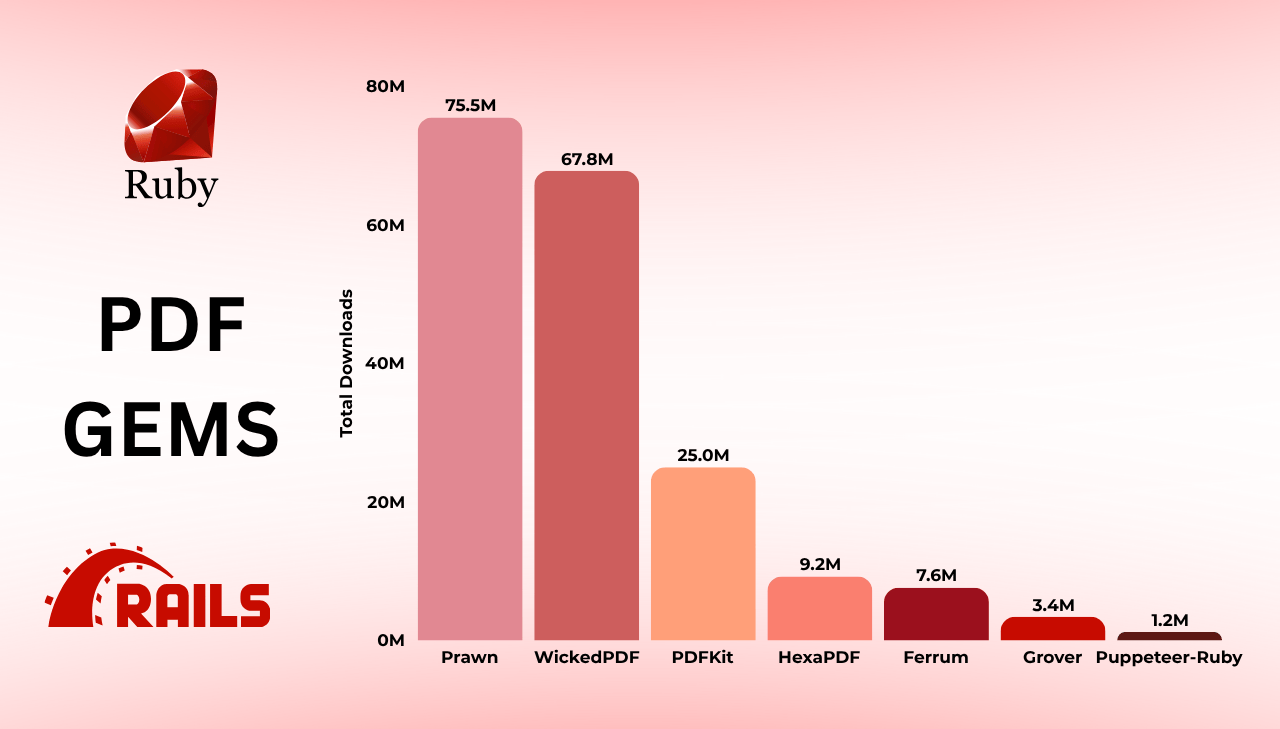
Ruby on Rails developers increasingly face complex PDF generation challenges that go far beyond simple document creation. Whether you're building automated invoice systems, generating compliance reports, or creating customer-facing certificates, choosing the right approach significantly impacts application performance, maintenance overhead, and development velocity. The Rails ecosystem in 2025 offers an exceptional variety of solutions – from battle-tested programmatic libraries to innovative browser-powered rendering engines. This comprehensive analysis examines the most popular Ruby PDF gems for Rails, backed by real download metrics, and practical code examples to guide your technology selection.
Ruby PDF Gem Download Statistics & Rankings 2025
Understanding library adoption through download metrics reveals important patterns in Rails developer preferences and real-world usage. We've analyzed data from multiple sources to provide comprehensive insights into the PDF generation gems ecosystem.
Ruby PDF Gem Rankings: BestGems.org Download Statistics
The following table presents statistics from BestGems.org, which tracks download metrics and popularity rankings across the entire Ruby gems ecosystem:
| Gem | BestGems Ranking | Total Downloads | Daily Downloads | First Release | Primary Purpose |
|---|---|---|---|---|---|
| Prawn | 🥇 635 | 75,530,840 | 87,665 | 2008 | PDF generation |
| WickedPDF | 🥇 708 | 67,753,243 | 46,724 | 2011 | HTML to PDF |
| PDFKit | 🥈 1,415 | 24,952,429 | 14,595 | 2010 | HTML to PDF |
| HexaPDF | 🥈 2,134 | 9,234,015 | 11,359 | 2016 | PDF generation and manipulation |
| Ferrum | 🥈 2,362 | 7,587,600 | 33,532 | 2019 | Browser automation |
| Grover | 🥉 3,363 | 3,386,451 | 4,657 | 2018 | HTML to PDF |
| Puppeteer-Ruby | 🥉 5,169 | 1,176,372 | 1,724 | 2020 | Browser automation |
All download statistics and GitHub metrics presented in this article reflect data from June 2025.
Ruby on Rails PDF Gems: Total Downloads Comparison
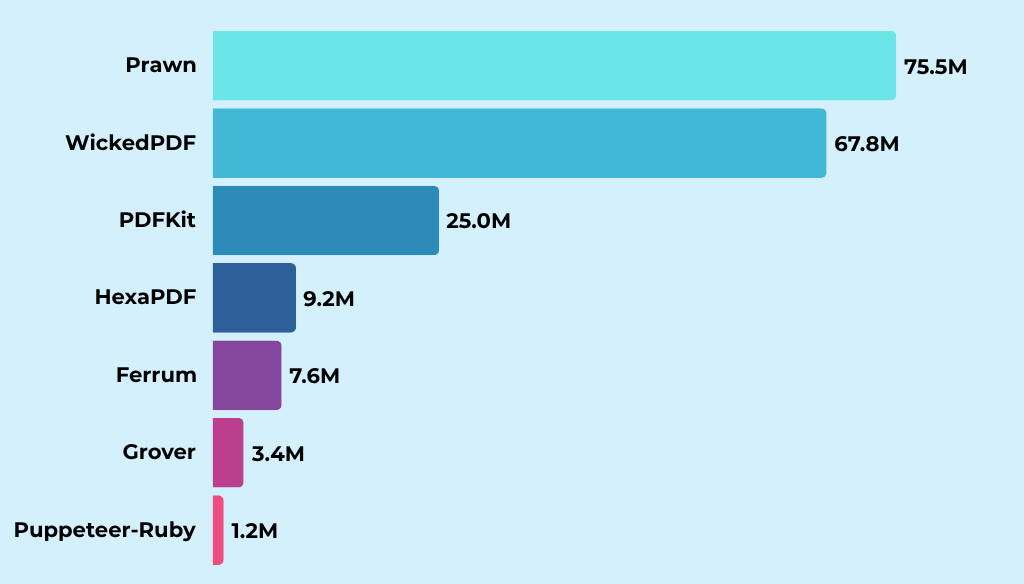
The chart illustrates the significant gap between mature libraries like Prawn and WickedPDF and emerging solutions in the Rails PDF landscape.
Ruby on Rails PDF Libraries: Daily Downloads Activity

Daily activity patterns reveal different adoption trends. Prawn maintains consistent leadership, while Ferrum shows stronger daily download momentum than libraries with higher total downloads, indicating growing developer adoption of modern browser automation tools. Ferrum's high daily downloads may primarily reflect its use in browser automation and testing, with PDF generation being one of many capabilities.
Ruby PDF Gems: GitHub Stars & Community Engagement
GitHub statistics provide valuable insights into community involvement, developer interest, and project activity beyond simple download numbers.
| Gem | GitHub Stars | Watchers | Forks |
|---|---|---|---|
| Prawn | 4.7k ⭐ | 95 | 698 |
| WickedPDF | 3.6k ⭐ | 52 | 651 |
| PDFKit | 2.9k ⭐ | 31 | 427 |
| Ferrum | 1.9k ⭐ | 25 | 147 |
| HexaPDF | 1.3k ⭐ | 18 | 73 |
| Grover | 1.0k ⭐ | 5 | 115 |
| Puppeteer-Ruby | 309 ⭐ | 9 | 43 |
Prawn dominates GitHub engagement metrics just as it leads in download statistics, while WickedPDF and PDFKit maintain strong community involvement, reflecting the established trust in these mature PDF generation solutions.
Best Ruby on Rails PDF Generation Libraries: Complete 2025 Guide
Let's explore each library with practical examples, feature analysis, and implementation guidance to inform your technology selection.
Prawn
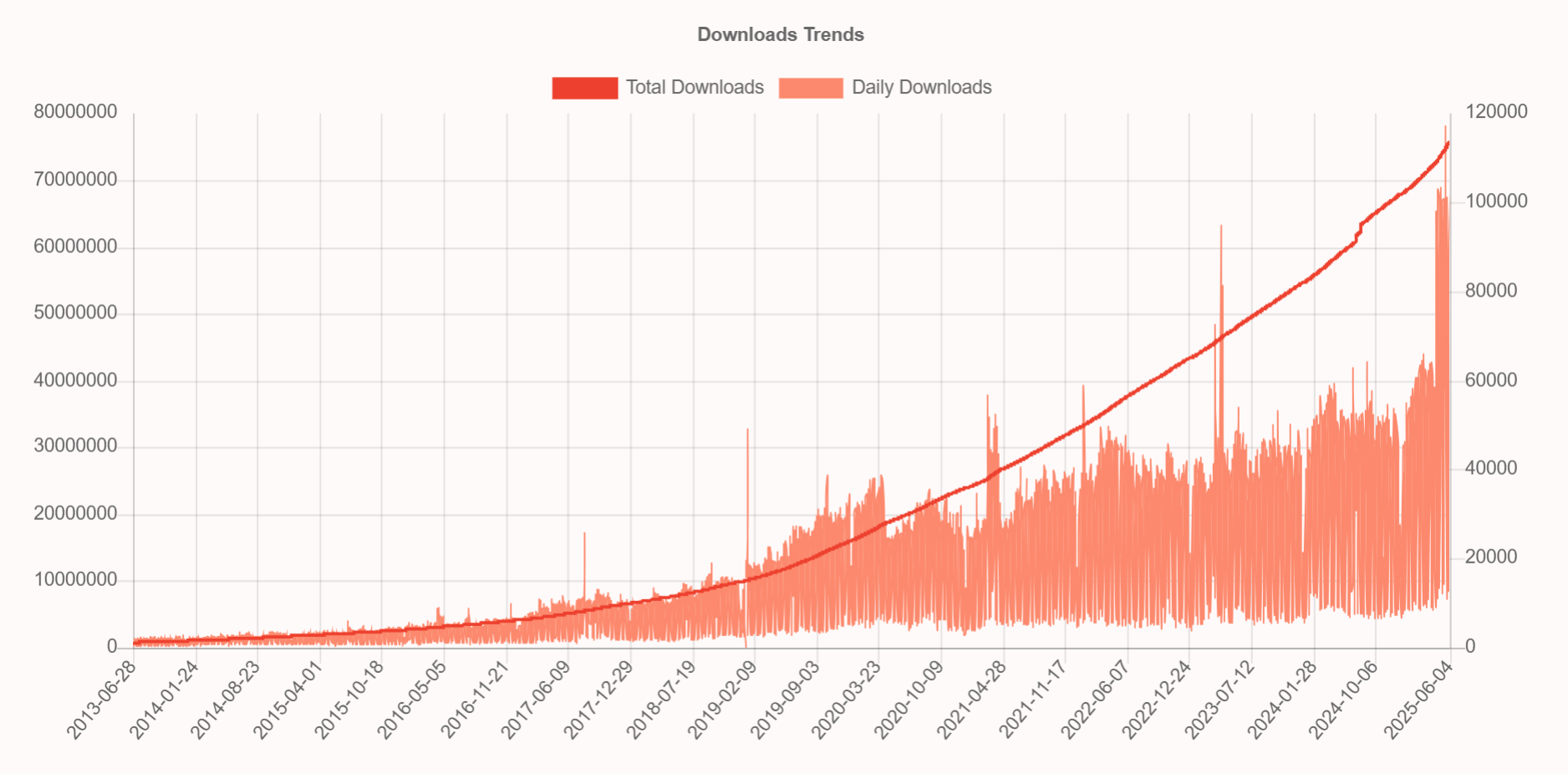
Prawn stands as the leading solution for programmatic PDF generation in Rails applications. This pure Ruby library provides precise control over document layout, typography, and design through an intuitive API that feels natural to Ruby developers.
➡️ Key Features:
- Pure Ruby implementation with no external binary dependencies.
- Programmatic document creation with pixel-perfect control.
- Rich text formatting and advanced typography support.
- Vector graphics and custom drawing capabilities.
- Multi-page document support with automatic pagination.
➡️ Key Constraints:
- No HTML to PDF conversion – designed for code-based document construction.
- Manual layout management required for complex document structures.
➡️ Installation:
gem install prawn
➡️ Basic Document Creation Example:
- Code
- PDF Preview
class DocumentsController < ApplicationController
def generate_pdf
# Create a new PDF document
pdf = Prawn::Document.new
# Add title
pdf.fill_color "2563eb"
pdf.text "PDF Generated with Prawn", size: 28, style: :bold, align: :center
pdf.fill_color "000000"
pdf.move_down 20
# Add some content
pdf.text "Why did the Ruby developer break up with Python?", size: 16, align: :center
pdf.move_down 15
pdf.text "Because they couldn't handle the whitespace in their relationship!",
size: 16, style: :bold, align: :center
# Generate and send PDF to browser for viewing
send_data pdf.render,
filename: "prawn-example.pdf",
type: "application/pdf",
disposition: "inline"
end
end

Explore advanced Prawn techniques in our comprehensive guide: Ruby on Rails PDF Generation with Prawn: Complete Tutorial.
WickedPDF

WickedPDF serves as Rails' most popular HTML to PDF converter, providing seamless integration with ERB templates and Rails conventions. Built as a wrapper around wkhtmltopdf, it enables developers to leverage existing HTML/CSS skills for PDF generation.
➡️ Key Features:
- Native Rails integration with familiar MVC patterns.
- HTML/CSS to PDF conversion.
- ERB template support with Rails helpers.
- Asset pipeline compatibility for stylesheets and images.
- Flexible configuration options for page layout and margins.
- Header and footer support with dynamic content.
➡️ Key Constraints:
- wkhtmltopdf dependency (archived project, but still functional).
- Limited modern CSS support due to older WebKit engine.
- No JavaScript execution for dynamic content.
➡️ Installation:
gem 'wicked_pdf'
WickedPDF requires the wkhtmltopdf binary to be installed on your system. You can either:
- Install via gem:
gem 'wkhtmltopdf-binary'(includes binary). - Download from: wkhtmltopdf.org.
➡️ HTML to PDF Conversion Example:
- Code
- PDF Preview
class DocumentsController < ApplicationController
def generate_pdf
# Define HTML content with embedded CSS
html_content = %{
<!DOCTYPE html>
<html>
<head>
<style>
body { font-family: Arial, sans-serif; text-align: center; }
h1 { color: #d32f2f; }
p { font-size: 26px; margin: 25px 0; }
</style>
</head>
<body>
<h1>PDF Generated with WickedPDF</h1>
<p>What's the difference between Ruby and a diamond?</p>
<p><strong>You can't code with a diamond!</strong></p>
</body>
</html>
}
# Convert HTML to PDF
pdf = WickedPdf.new.pdf_from_string(html_content)
# Send PDF to browser for viewing
send_data pdf,
filename: "wickedpdf-example.pdf",
type: "application/pdf",
disposition: "inline"
end
end
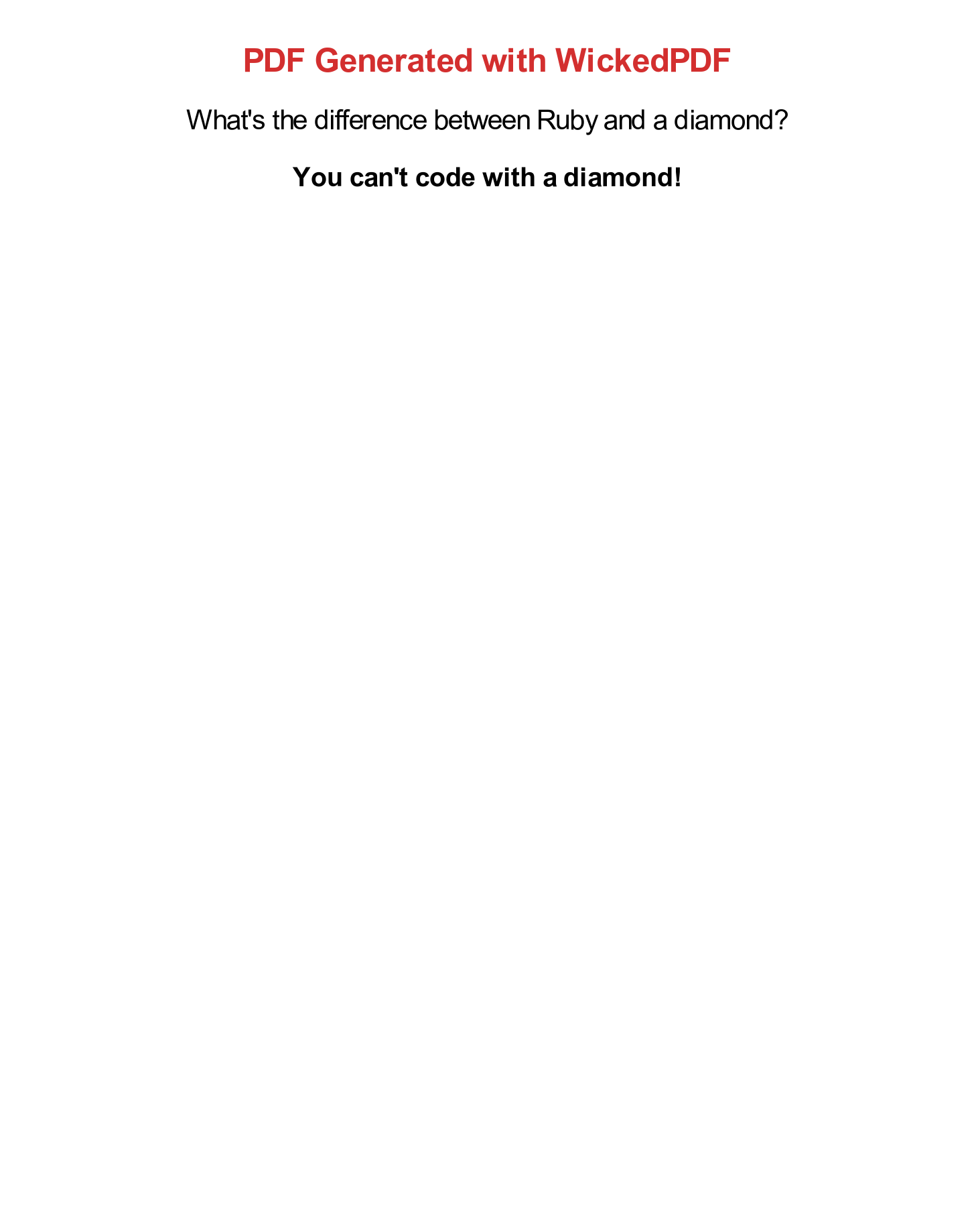
Master WickedPDF implementation with our detailed tutorial: Ruby on Rails: Convert HTML to PDF with WickedPDF.
PDFKit
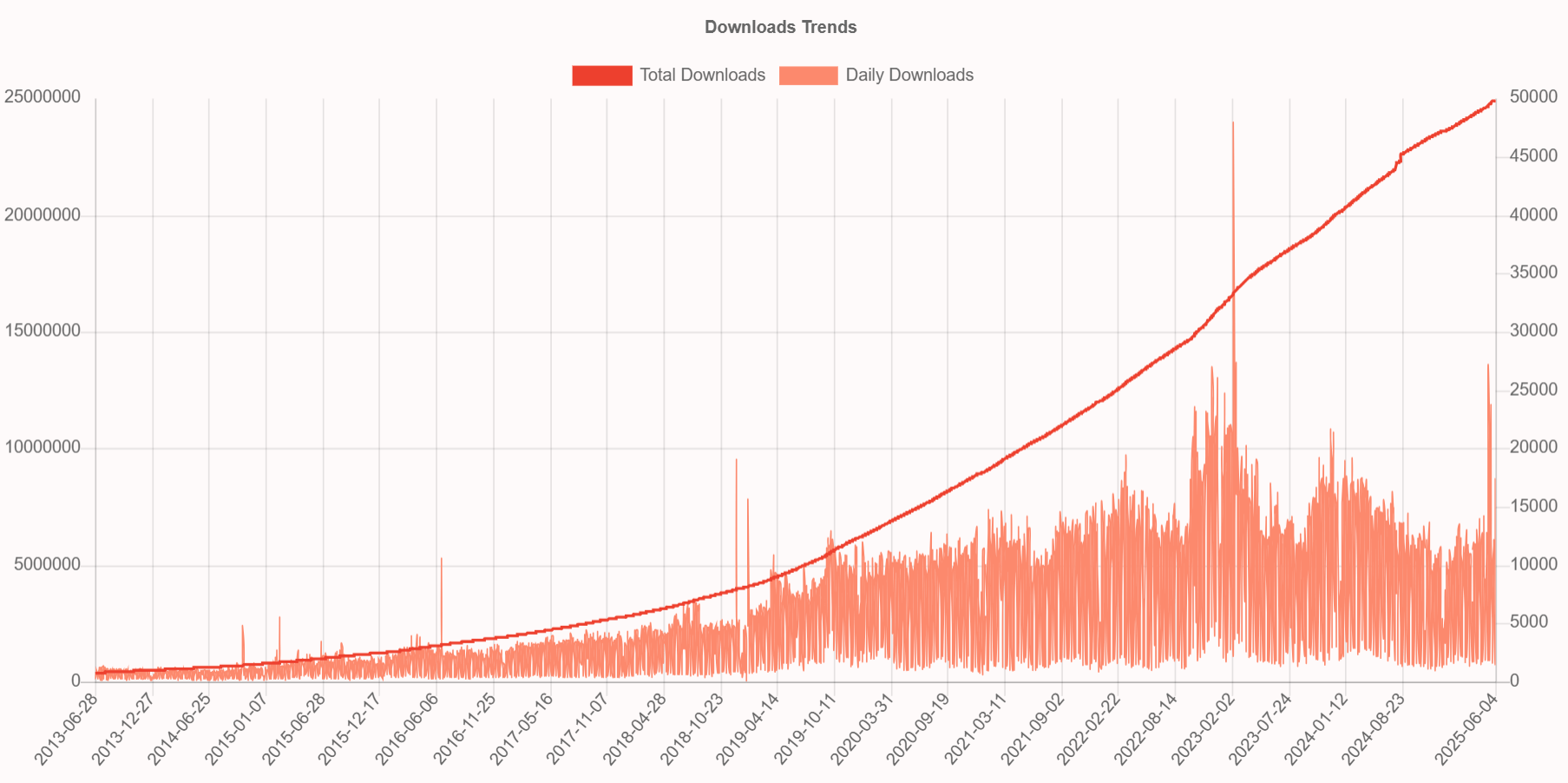
PDFKit is a well-established HTML to PDF converter that wraps the wkhtmltopdf binary. Similar to WickedPDF but with a different API approach, PDFKit provides reliable HTML to PDF conversion with extensive configuration options.
➡️ Key Features:
- Clean API accepting HTML strings, URLs, or file paths.
- Access to all wkhtmltopdf options.
- Qt WebKit rendering engine.
- Configurable headers and footers.
- Image and asset embedding support.
➡️ Key Constraints:
- Deprecated wkhtmltopdf dependency (archived).
- Limited modern CSS support.
- Requires separate installation and management of the wkhtmltopdf binary.
➡️ Installation:
gem 'pdfkit'
PDFKit requires wkhtmltopdf binary to be installed on your system (same dependency as WickedPDF). You can either:
- Install via gem:
gem 'wkhtmltopdf-binary'(easiest option). - Download manually from: wkhtmltopdf.org and configure the binary path in
config/initializers/pdfkit.rb.
➡️ HTML to PDF Conversion Example:
- Code
- PDF Preview
class DocumentsController < ApplicationController
def generate_pdf
# Define HTML content
html_content = %{
<!DOCTYPE html>
<html>
<head>
<style>
body { font-family: Arial, sans-serif; text-align: center; }
h1 { color: #936e2d; }
p { font-size: 26px; margin: 25px 0; }
</style>
</head>
<body>
<h1>PDF Generated with PDFKit</h1>
<p>What's a Ruby developer's favorite type of music?</p>
<p><strong>Heavy Meta(programming)!</strong></p>
</body>
</html>
}
# Create PDF
kit = PDFKit.new(html_content, page_size: 'A4')
pdf = kit.to_pdf
# Send PDF to browser
send_data pdf,
filename: "pdfkit-example.pdf",
type: "application/pdf",
disposition: "inline"
end
end
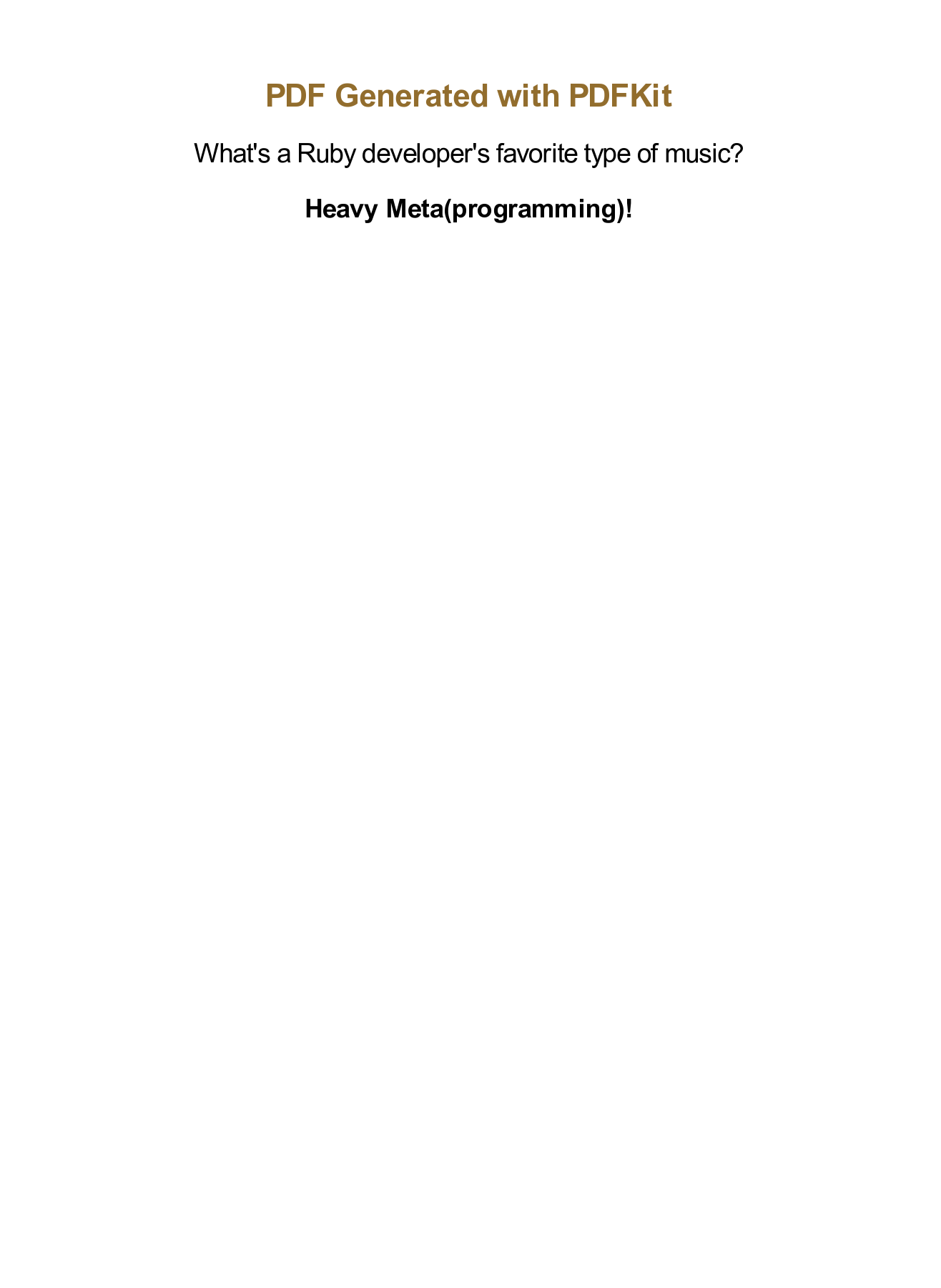
Master PDFKit implementation with detailed configuration options and troubleshooting guide: PDFKit Official Documentation.
HexaPDF
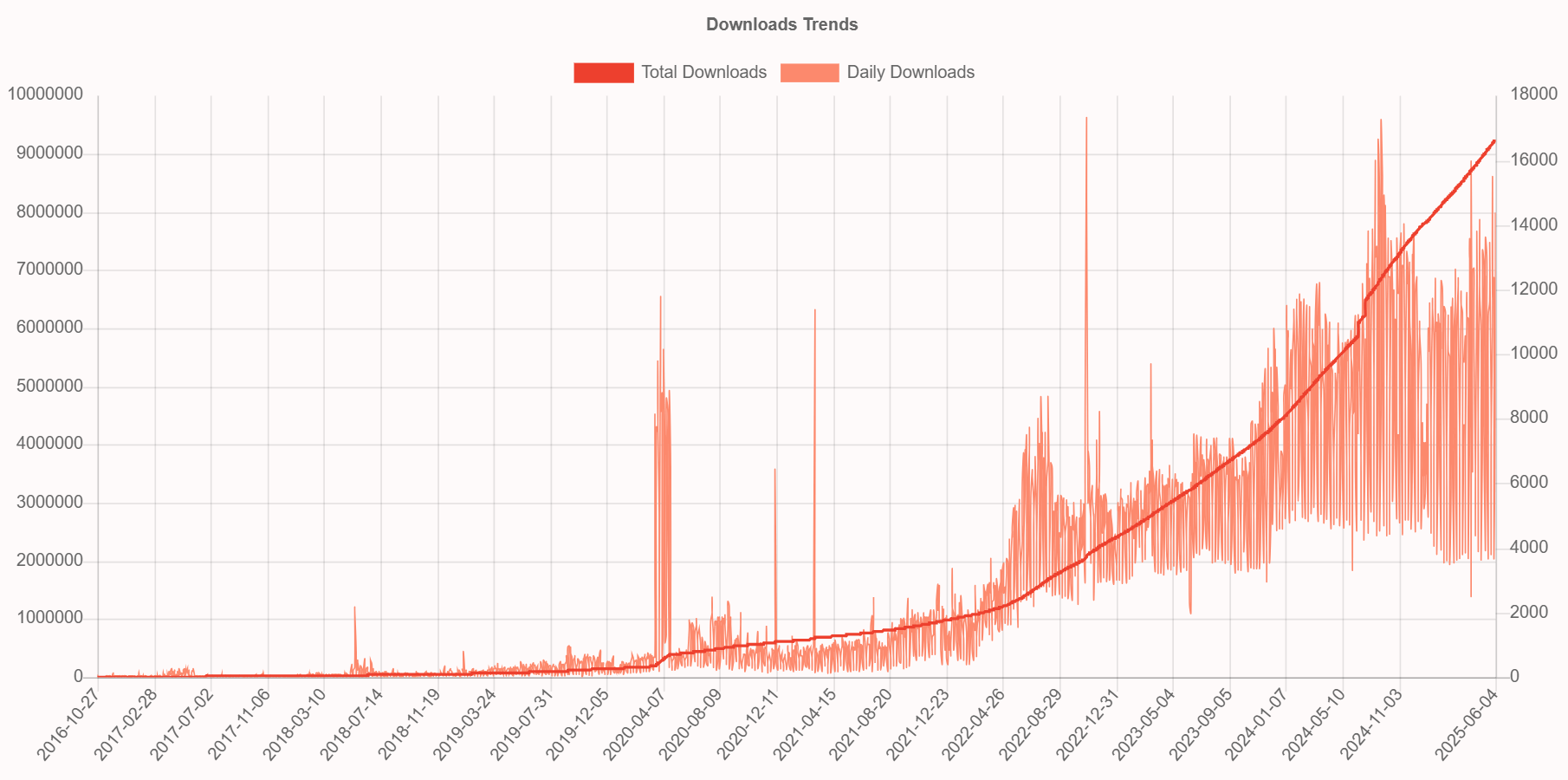
HexaPDF represents a comprehensive pure Ruby PDF solution, offering both document creation and advanced manipulation capabilities. Unlike libraries focused solely on generation, HexaPDF provides complete PDF lifecycle management including editing, merging, encryption, and optimization.
➡️ Key Features:
- Pure Ruby implementation with comprehensive PDF support.
- Document manipulation capabilities (edit, merge, split existing PDFs).
- Advanced security features including encryption and digital signatures.
- PDF optimization for file size reduction.
- Form handling with AcroForm support.
➡️ Key Constraints:
- Dual licensing model (AGPL for open source, commercial license required for proprietary use).
- No HTML to PDF conversion – focused on programmatic PDF creation.
- Less extensive ecosystem compared to Prawn.
➡️ Installation:
gem 'hexapdf'
➡️ Document Creation Example:
- Code
- PDF Preview
class DocumentsController < ApplicationController
def generate_pdf
# Create a new PDF document
doc = HexaPDF::Document.new
page = doc.pages.add
canvas = page.canvas
# Add title
canvas.font('Helvetica', size: 28, variant: :bold)
canvas.fill_color(0.6, 0.2, 0.8)
canvas.text("PDF Generated with HexaPDF", at: [120, 750])
# Add content
canvas.font('Helvetica', size: 16)
canvas.fill_color(0, 0, 0)
canvas.text("What do you call a Ruby method that won't stop talking?", at: [80, 700])
canvas.font('Helvetica', size: 16, variant: :bold)
canvas.text("A verbose method!", at: [220, 670])
# Generate and send PDF to browser for viewing
send_data doc.write_to_string,
filename: "hexapdf-example.pdf",
type: "application/pdf",
disposition: "inline"
end
end
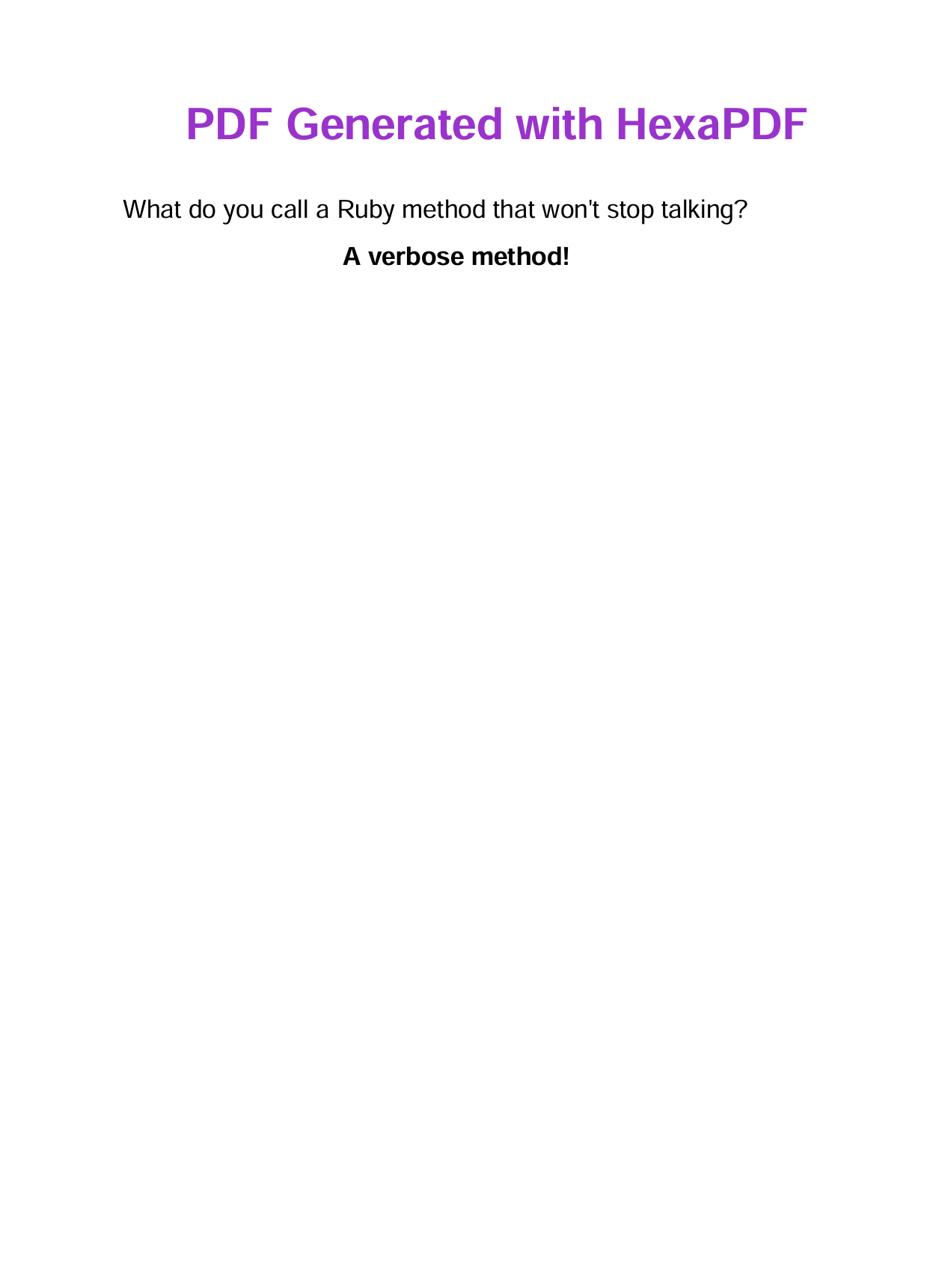
Discover HexaPDF's full potential: HexaPDF Ruby Tutorial: PDF Generation for Rails.
Ferrum & FerrumPDF
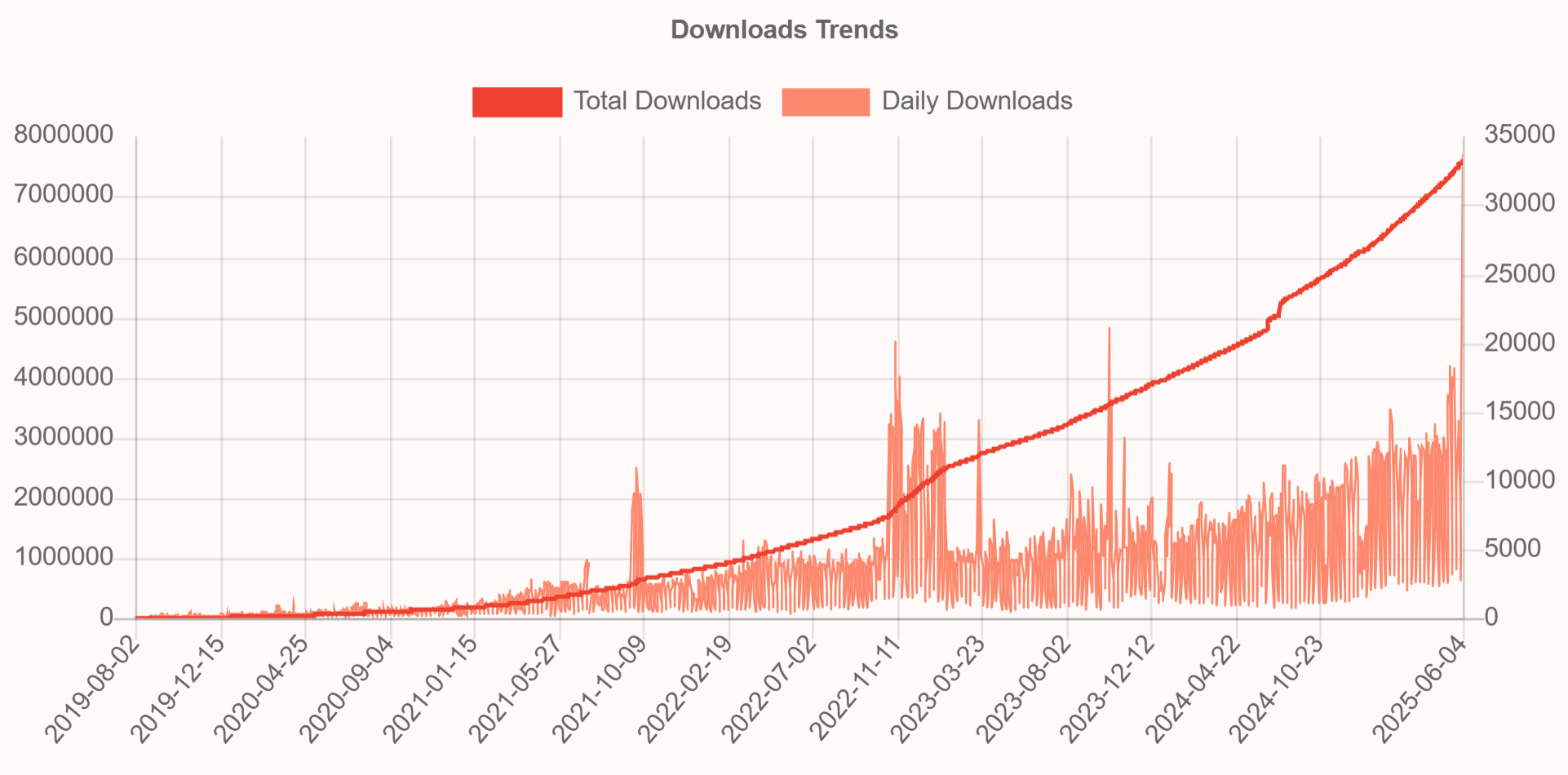
Ferrum is primarily a pure Ruby browser automation tool that provides direct access to Chrome DevTools Protocol without Node.js dependencies. While designed for web scraping, testing, and browser automation, Ferrum can also generate PDFs as part of its comprehensive browser control capabilities.
➡️ Key Features:
- Pure Ruby Chrome automation without Node.js dependencies.
- Chrome DevTools Protocol access for advanced browser control.
- Modern HTML5, CSS3, and JavaScript support through Chrome engine.
- Multi-purpose tool: web scraping, testing, and PDF generation.
- Screenshot and PDF capabilities as part of browser automation.
➡️ Key Constraints:
- Primary purpose is browser automation, not dedicated PDF generation.
- Chrome binary management and configuration required.
- Limited PDF-specific features compared to dedicated solutions.
For dedicated PDF generation in Rails, consider FerrumPDF, which provides a Rails-optimized wrapper around Ferrum specifically designed for PDF generation with convenient helper methods and better Rails integration.
➡️ Installation FerrumPDF:
# For Rails-optimized PDF generation
gem 'ferrum_pdf'
Both gems require Chrome to be installed on your system.
➡️ HTML to PDF Generation with FerrumPDF:
- Code
- PDF Preview
class DocumentsController < ApplicationController
def generate_pdf
html_content = %{
<!DOCTYPE html>
<html>
<head>
<style>
body { font-family: Arial, sans-serif; text-align: center; }
h1 { color: #bc18bc; }
p { font-size: 26px; margin: 25px 0; }
</style>
</head>
<body>
<h1>PDF Generated with FerrumPDF</h1>
<p>Why did the Rails developer become a DJ?</p>
<p><strong>He was really good at spinning up new instances!</strong></p>
</body>
</html>
}
pdf_data = FerrumPdf.render_pdf(
html: html_content,
pdf_options: {
format: :A4,
print_background: true
}
)
send_data pdf_data,
filename: "ferrum_pdf_example.pdf",
type: "application/pdf",
disposition: "inline"
end
end

FerrumPDF combines the power of Chrome rendering with Rails conventions. Recent adoption shows developers are moving from Grover to FerrumPDF to eliminate Node.js dependencies. Check out the FerrumPDF documentation for advanced features.
Grover

Grover delivers modern HTML to PDF conversion using Google Chrome's rendering engine through Puppeteer. This approach ensures pixel-perfect rendering of contemporary CSS features including Flexbox, Grid, and JavaScript-driven content.
➡️ Key Features:
- Chrome-based rendering for high-fidelity PDF output.
- Modern CSS support including Flexbox and Grid.
- JavaScript execution for dynamic content rendering.
- Flexible configuration options for page formatting.
- High compatibility with modern web standards.
➡️ Key Constraints:
- Node.js and Puppeteer dependencies increase infrastructure complexity.
- Higher resource consumption compared to lightweight alternatives.
- Browser binary management required for deployment.
➡️ Installation:
gem 'grover'
Grover requires Node.js and Puppeteer to be installed on your system:
- Install Node.js from: nodejs.org
- Install Puppeteer:
npm install puppeteer
➡️ HTML to PDF Conversion Example:
- Code
- PDF Preview
class DocumentsController < ApplicationController
def generate_pdf
# Define HTML content with embedded CSS
html_content = %{
<!DOCTYPE html>
<html>
<head>
<style>
body { font-family: Arial, sans-serif; text-align: center; padding: 40px 0; }
h1 { color: #057c37; }
p { font-size: 26px; margin: 25px 0; }
</style>
</head>
<body>
<h1>PDF Generated with Grover</h1>
<p>Why did the Ruby programmer throw away his calendar?</p>
<p><strong>Because he believed in the <code>timeless gem</code>!</strong></p>
</body>
</html>
}
# Convert HTML to PDF using Chrome engine
pdf = Grover.new(html_content).to_pdf
# Send PDF to browser for viewing
send_data pdf,
filename: "grover-example.pdf",
type: "application/pdf",
disposition: "inline"
end
end
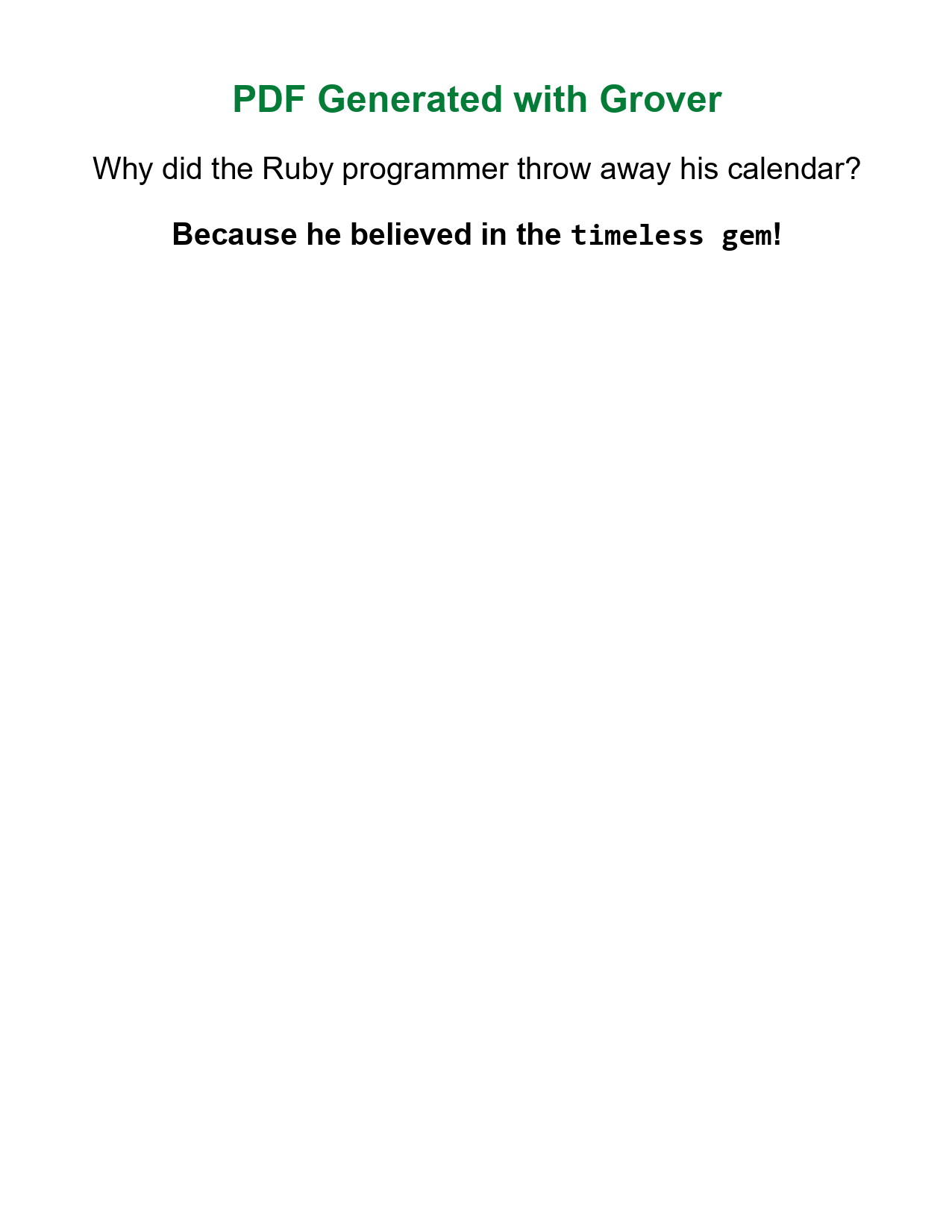
Complete Grover implementation guide: HTML to PDF in Rails: Complete Guide with Grover Gem.
Puppeteer-Ruby
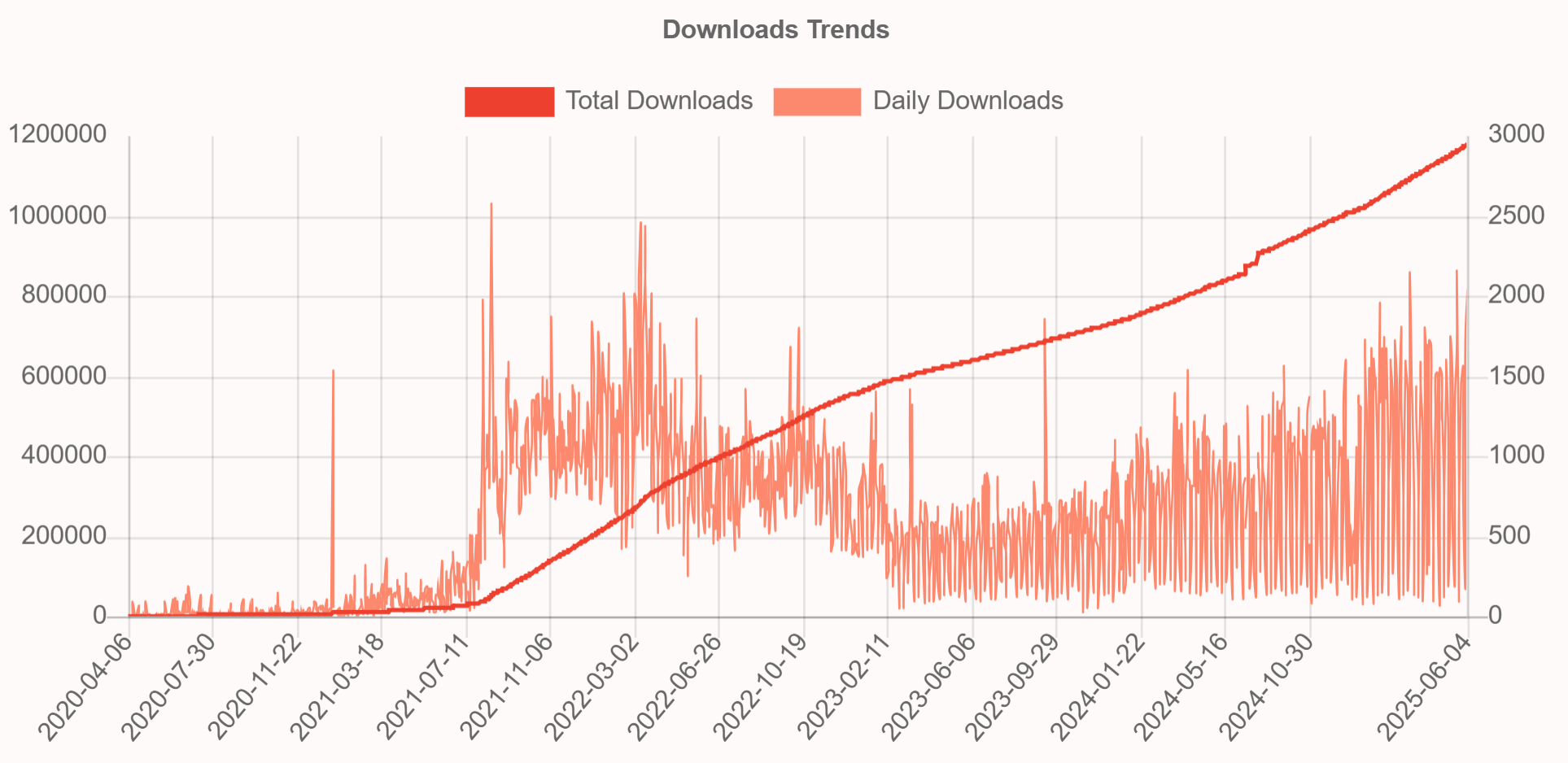
Puppeteer-Ruby provides a Ruby port of Google's Puppeteer API, offering access to Chrome's rendering capabilities. This solution gives developers browser automation control while maintaining Ruby's familiar syntax and conventions.
➡️ Key Features:
- Pure Ruby implementation for Chrome automation.
- Modern CSS3, Flexbox, Grid, and JavaScript support.
- Chrome rendering engine for high-quality PDFs.
- Compatible with Rails applications and workflows.
- Configurable PDF formats, margins, headers and more.
➡️ Key Constraints:
- Complex setup compared to simpler alternatives.
- Higher resource consumption due to full browser automation.
- Covers only a subset of the full Puppeteer API.
➡️ Installation:
gem 'puppeteer-ruby'
Ensure Chrome/Chromium is installed.
➡️ HTML to PDF Conversion Example:
- Code
- PDF Preview
class DocumentsController < ApplicationController
def generate_pdf
# Define HTML content with embedded CSS
html_content = %{
<!DOCTYPE html>
<html>
<head>
<style>
body { font-family: Arial, sans-serif; text-align: center; padding: 40px 0; }
h1 { color: #f56e01; }
p { font-size: 26px; margin: 25px 0; }
</style>
</head>
<body>
<h1>PDF Generated with Puppeteer-Ruby</h1>
<p>Why did the Ruby programmer go to therapy?</p>
<p><strong>He had too many unresolved dependencies!</strong></p>
</body>
</html>
}
# Generate PDF using Puppeteer-Ruby
pdf_data = Puppeteer.launch(headless: true) do |browser|
page = browser.new_page
page.set_content(html_content)
page.pdf(format: 'A4', print_background: true)
end
# Send PDF to browser for viewing
send_data pdf_data,
filename: "puppeteer-ruby-example.pdf",
type: "application/pdf",
disposition: "inline"
end
end
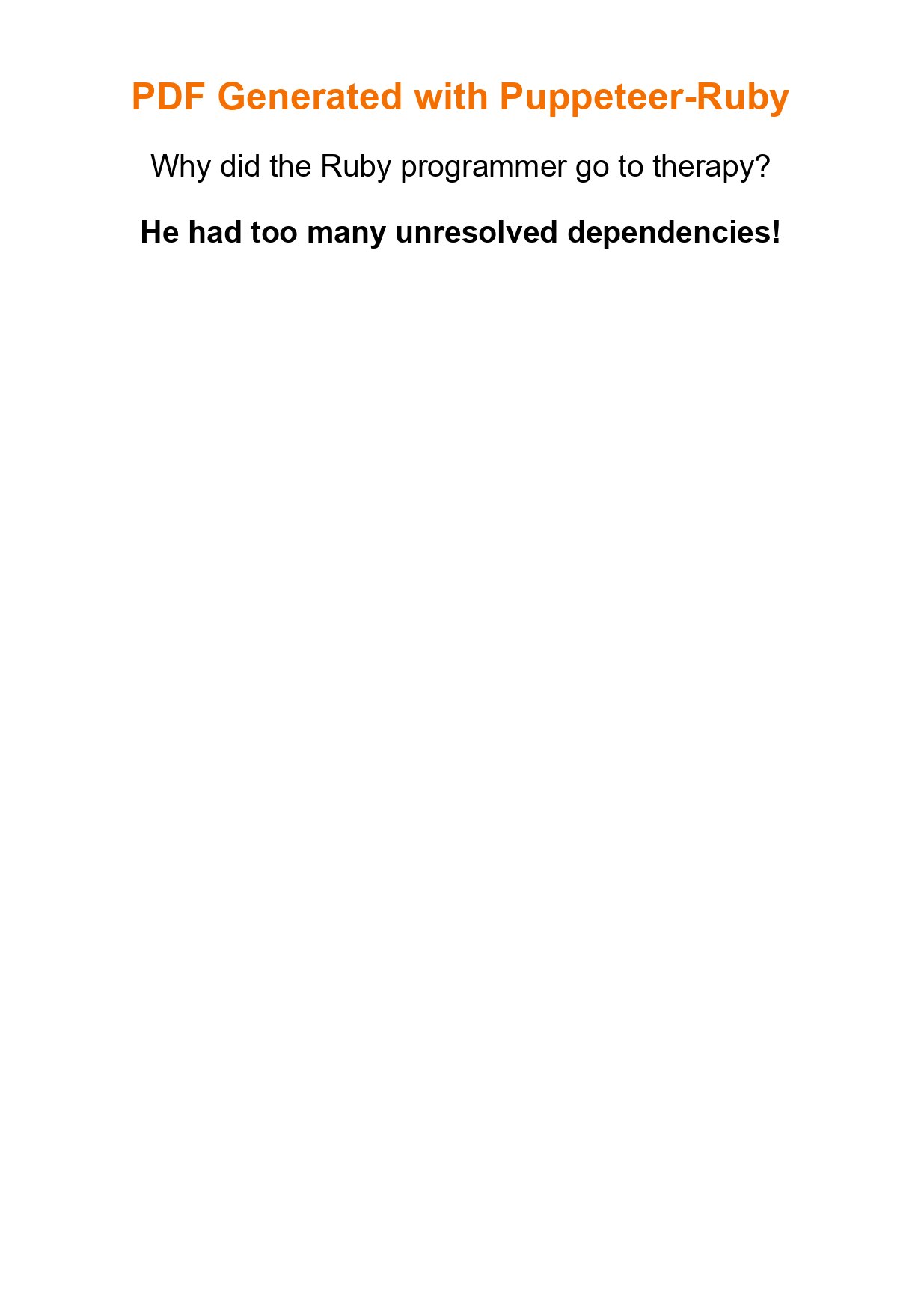
Advanced Puppeteer-Ruby implementation: HTML to PDF in Rails with Puppeteer-Ruby.
Ruby on Rails PDF Libraries Comparison: Features & Performance
This comprehensive comparison analyzes the most popular Ruby PDF generation gems across essential features, helping you choose the optimal solution for your specific Rails project requirements.
| Feature | Prawn | WickedPDF | PDFKit | HexaPDF | Grover | Puppeteer-Ruby | FerrumPDF |
|---|---|---|---|---|---|---|---|
| HTML to PDF | No | Yes | Yes | No | Yes | Yes | Yes |
| Modern CSS | N/A | Basic (CSS2) | Basic (CSS2) | N/A | Full | Full | Full |
| JavaScript | No | Limited | Limited | No | Full | Full | Full |
| Dependencies | None | wkhtmltopdf | wkhtmltopdf | geom2d cmdparse | Node.js + Puppeteer | Chrome/ Chromium | Chrome/ Chromium |
| Approach | Programmatic | HTML conversion | HTML conversion | Programmatic | Browser- based | Browser- based | Browser- based |
| Performance | High | Moderate | Moderate | High | Moderate | Moderate | Moderate |
| Memory Usage | Low | Low | Low | Low | High | High | Moderate |
| License | GPLv2+/ GPLv3 | MIT | MIT | AGPL/ Commercial | MIT | Apache 2.0 | MIT |
| Rails Integration | Good | Excellent | Good | Good | Excellent | Good | Excellent |
| PDF Manipulation | Basic | No | No | Advanced | No | No | No |
- MIT/Apache 2.0: Free for commercial use, no restrictions.
- GPLv2+/GPLv3 (Prawn): Copyleft - requires open-sourcing your application if distributed.
- AGPL/Commercial (HexaPDF): Free with open-source requirement, or paid license for commercial use.
How to Choose the Best PDF Gem for Ruby on Rails Projects
Selecting the optimal Ruby PDF generation gem depends on your specific project requirements, technical constraints, and development preferences. Use this practical guide to match common Rails scenarios with the most suitable library solutions.
| Use Case | Recommended Libraries | Reasoning |
|---|---|---|
| Programmatic PDFs | • Prawn • HexaPDF | Full control, code-based generation, complex layouts from scratch. |
| Modern HTML to PDF | • Grover • FerrumPDF • Puppeteer-Ruby | Full CSS3, JavaScript, modern web standards support. |
| Basic HTML to PDF | • WickedPDF • PDFKit | Simple templates, basic CSS only. Note: wkhtmltopdf archived in 2023. |
| High-Volume Production | • Prawn • HexaPDF | Superior performance, minimal dependencies, efficient resource usage. |
| PDF Manipulation | • HexaPDF | Merge, split, encrypt, optimize existing PDFs, form handling. |
| Enterprise/Compliance | • HexaPDF | Digital signatures, encryption, PDF/A standards, regulatory requirements. |
Ruby on Rails PDF Library Selection: Key Decision Factors:
-
HTML vs Programmatic approach: Do you need HTML template conversion or code-based document construction?
-
Modern CSS requirements: Do your designs need Flexbox, Grid, or other modern CSS features?
-
JavaScript dependency: Do your PDFs need dynamic content or interactive elements?
-
Infrastructure preferences: Do you prefer managed services over self-hosted dependencies?
-
Performance and scalability: Do you need auto-scaling for traffic spikes or high-volume generation?
-
Licensing/pricing: Are you limited to open source solutions or can you use commercial options?
-
Team focus: Would you rather focus on core business logic than managing PDF infrastructure?
-
Development velocity: Do you prioritize fast implementation and ease of use?
-
Long-term maintenance: Do you want guaranteed support and automatic updates without managing infrastructure yourself?
HTML to PDF API Solutions for Ruby on Rails Applications
For teams seeking to minimize infrastructure complexity while achieving enterprise-grade PDF generation, cloud-based HTML to PDF API services like PDFBolt offer compelling advantages over self-hosted Ruby libraries.
If multiple decision factors above pointed toward managed solutions, API-based PDF generation can eliminate infrastructure overhead while providing superior capabilities.
Benefits of API-Based PDF Generation
Cloud-based HTML to PDF API services like PDFBolt deliver powerful advantages:
Infrastructure Simplification:
- No browser binary installation or maintenance.
- Eliminate Node.js, wkhtmltopdf, or Chrome dependency management.
- Zero server provisioning for PDF workloads.
Modern Web Standards:
- Latest Chrome rendering engine with full CSS3, Flexbox, and Grid support.
- JavaScript execution for dynamic content generation.
- Complete web font and modern typography support.
Enterprise Reliability:
- Automatic scaling for traffic spikes and high-volume generation.
- Guaranteed rendering consistency across all environments.
- Privacy-focused processing with no sensitive data retention or logging.
Developer Experience:
- Simple HTTP API integration with any Ruby application.
- Async processing and webhook notifications for large documents.
- Direct cloud storage integration with your S3 bucket.
- Easy team collaboration with logs and usage analytics.
Ruby on Rails HTML to PDF API Integration Example
Integrating PDFBolt HTML to PDF API into your Rails application provides a simple yet powerful alternative to managing PDF dependencies locally. This example demonstrates how to convert HTML content to PDF using a straightforward API call.
➡️ Installation:
# HTTP client for API requests
gem 'faraday'
➡️ HTML to PDF API Conversion Example:
- Code
- PDF Preview
class DocumentsController < ApplicationController
def generate_pdf
# Define HTML content with embedded CSS
html_content = %{
<!DOCTYPE html>
<html>
<head>
<style>
body { font-family: Arial, sans-serif; text-align: center; padding: 40px 0; }
h1 { color: #008be8; }
p { font-size: 26px; margin: 25px 0; }
</style>
</head>
<body>
<h1>PDF Generated with PDFBolt API</h1>
<p>How do you know when a Rails developer is feeling sad?</p>
<p><strong>They start writing pessimistic migrations!</strong></p>
</body>
</html>
}
begin
# Make API request to PDFBolt service
response = Faraday.post('https://api.pdfbolt.com/v1/direct') do |req|
req.headers['Content-Type'] = 'application/json'
req.headers['API_KEY'] = 'XXXXXXXX-XXXX-XXXX-XXXX-XXXXXXXXXXXX'
req.body = {
html: Base64.strict_encode64(html_content), # Encode HTML content
format: 'A4',
printBackground: true
}.to_json
end
if response.success?
# Send PDF to browser for viewing
send_data response.body,
filename: "pdfbolt-example.pdf",
type: "application/pdf",
disposition: "inline"
else
render plain: "PDF generation failed. Status: #{response.status}, Body: #{response.body}", status: 500
end
rescue => e
render plain: "PDF generation error: #{e.message}", status: 500
end
end
end

Explore advanced PDF generation capabilities: PDFBolt HTML to PDF API Documentation.
Conclusion
The Ruby on Rails PDF generation landscape in 2025 offers a rich selection of libraries to suit virtually any requirement. Prawn continues to dominate as the gold standard for programmatic PDF creation in Ruby, while WickedPDF and PDFKit maintain their positions as go-to solutions for Rails HTML to PDF conversion.
Modern browser-based PDF generation solutions like Grover, Puppeteer-Ruby, and FerrumPDF represent the future of Rails PDF libraries, offering unparalleled support for contemporary web standards and JavaScript-driven content. HexaPDF emerges as the premier choice for Rails applications with advanced PDF manipulation requirements.
For Rails developers seeking scalable PDF solutions, cloud-based HTML to PDF APIs like PDFBolt offer the ultimate infrastructure-free approach with enterprise-grade HTML to PDF conversion and automatic scaling.
By understanding each library's strengths, constraints and optimal use cases, you can confidently select the best Ruby PDF generation gem for your project requirements, ensuring efficient PDF generation in Rails applications.
If generating PDFs feels harder than explaining metaprogramming, you’ve picked the wrong gem! 💎
